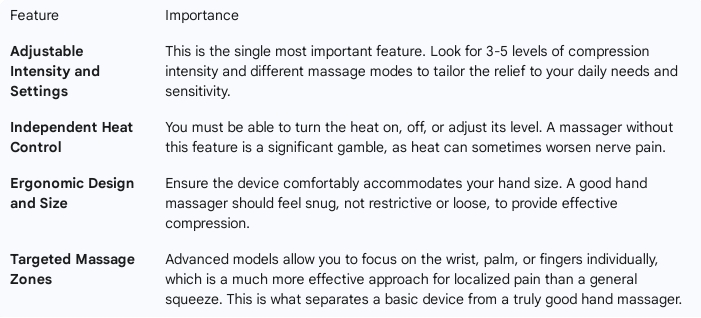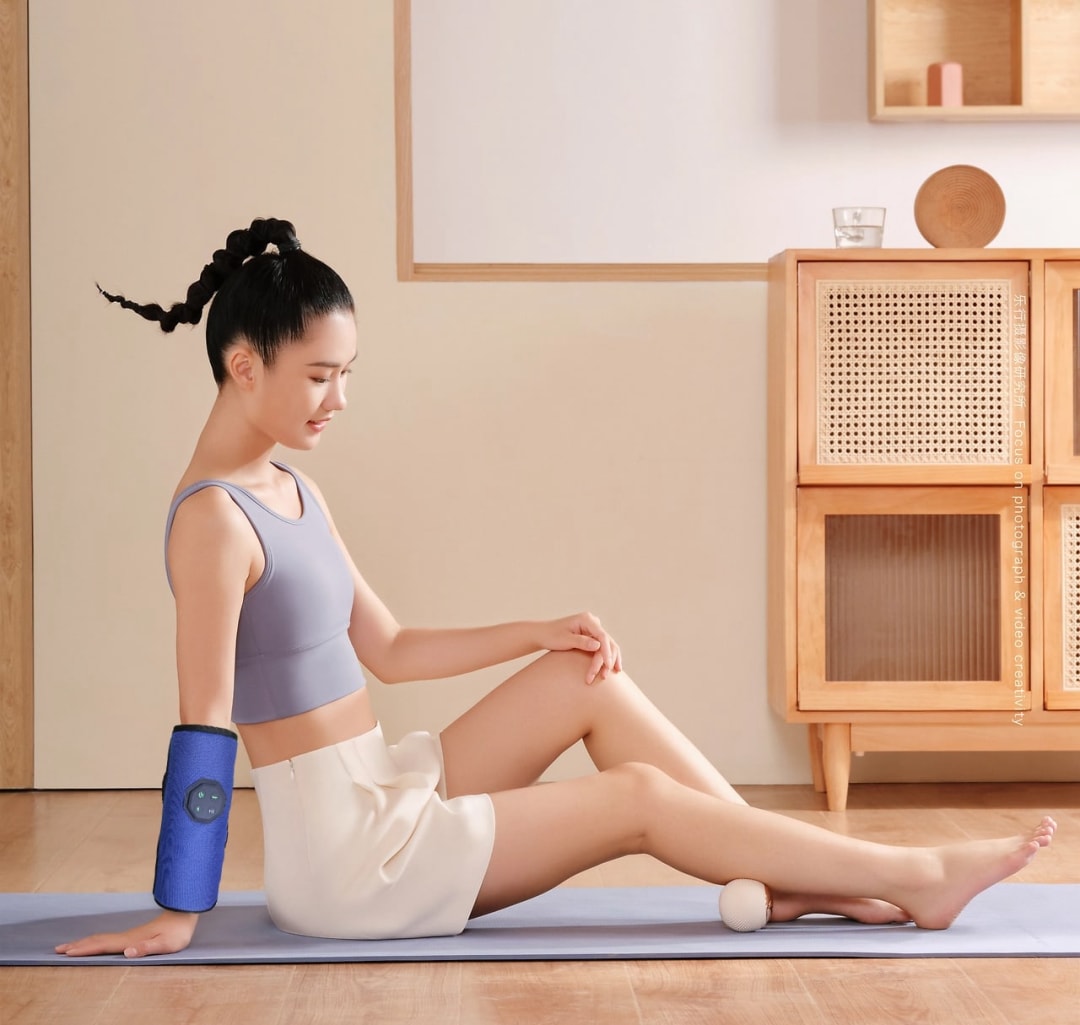A Good Hand Massager for Desk Pain? A User's Guide
- By Grace
- Updated on
If you're an office worker or someone nursing a sports injury, you’ve likely felt that familiar ache, stiffness, or tingling in your hands and wrists. In searching for relief, you’ve probably seen them: sleek, futuristic electric hand massagers flooding marketplaces like Amazon, all promising to soothe your pain away. But the core question remains: are they a revolutionary tool for hand health, or just an overhyped gadget? The promises are big, but the user reviews are a mixed bag, making the search for a good hand massager feel overwhelming.
As a consultant focused on evaluating health products, I've seen countless devices make bold claims, but finding a genuinely good hand massager requires looking past the hype. The truth is, the value of an electric hand massager isn't a simple yes or no. It depends entirely on the technology inside, your specific symptoms, and frankly, managing your expectations. Let's cut through the marketing noise and analyze what these devices can—and can't—do for your hands, so you can determine if a good hand massager is the right investment for you.
What’s Happening Inside Your Aching Hands?
Before we can judge the solution, it's crucial to understand the problem. For office workers, the culprit is often Repetitive Strain Injury (RSI). Hours spent typing and clicking create micro-trauma in the muscles and tendons of the hands and wrists. This leads to inflammation, soreness, and that all-too-common feeling of stiffness. For those with sports injuries, a sprain or impact can cause similar inflammation, but the body's healing process can also create scar tissue, limiting flexibility long after the initial injury has healed.
Then there's the big one: Carpal Tunnel Syndrome. This condition occurs when the median nerve, which runs through a narrow passageway in your wrist called the carpal tunnel, becomes compressed. This compression is what causes the classic symptoms of numbness, tingling, and weakness in the hand and fingers. It’s not just about sore muscles; it’s about nerve pressure, and that's a very different beast to tame. Understanding this distinction is the first step in finding a truly good hand massager for your needs. It's this kind of complex issue that a good hand massager aims to soothe, if not cure.
The Science Behind Electric Hand Massagers: Compression, Heat, and Vibration
Most electric hand massagers rely on a combination of three core technologies. The primary mechanism in any good hand massager is usually air compression. Internal airbags inflate and deflate in a rhythmic sequence, squeezing your hand and wrist. Think of it like a modern, automated blood pressure cuff for your hand. This action is designed to mimic the effleurage and petrissage strokes of a traditional massage, aiming to increase blood circulation and help reduce the fluid buildup that contributes to swelling and stiffness. A device that does this well can feel like a gentle wrist compressor, providing a comforting, encompassing pressure.
Next up is heat, and this is where the controversy really begins, especially for carpal tunnel. On one hand, warmth is fantastic for soothing sore, tight muscles. It increases blood flow and can make tissues more pliable. However, for a condition involving nerve inflammation, some experts argue that adding heat can actually worsen the problem by increasing swelling and pressure on the nerve. Others believe gentle heat can reduce inflammation and loosen scar tissue. This is why a truly good hand massager will always give you independent control over the heat function.
Finally, there's the vibration or "acupressure" feature. Some users describe this as a "weird acupuncture technology," and they aren't entirely wrong. These massagers often have small nodes on the interior surface that press into specific points on the palm and fingers while vibrating. From a scientific standpoint, this works on the "gate control theory of pain." The vibration and pressure signals travel to your brain faster than the pain signals, effectively distracting your brain from the ache. For some, this provides profound, albeit temporary, relief. A good hand massager often blends this feature subtly with compression for a more comprehensive experience.

The Real-World Verdict: Potential Benefits and Proven Limitations
So, putting it all together, what can you realistically expect from even a good hand massager? Based on a combination of user feedback and the underlying principles, these devices have clear strengths and weaknesses. A good hand massager can be a valuable tool for comfort and temporary relief, but it's essential to know its boundaries. It’s not a magic cure, and for certain conditions, other tools may be more appropriate.
It's important to recognize that for structural support, especially after an injury, a massager is not a substitute for a proper medical device. A targeted wrist brace for sprain or a sturdy athletic wrist support is designed for stabilization, which a massager does not provide. Similarly, while a good hand massager might alleviate symptoms associated with carpal tunnel, it won't function in the same way as medically prescribed carpal tunnel wrist braces, which are designed to keep the wrist in a neutral position to relieve nerve pressure, especially at night.
- Proven Benefits:
- General Stiffness and Soreness: Excellent for relieving muscle fatigue after a long day of typing or manual work.
- Improved Circulation: The combination of compression and heat is effective for warming up cold hands and improving blood flow.
- Stress Relief and Relaxation: The simple act of a 15-minute massage can be psychologically calming and serve as a powerful distraction from chronic pain.
- Proven Limitations:
- Not a "Cure": These devices do not "fix" underlying medical conditions like severe arthritis or carpal tunnel syndrome. They only manage symptoms.
- Effectiveness Varies: The experience is highly subjective and depends on the quality of the device and the user's specific anatomy and condition.
- Heat Controversy: The risk of aggravating nerve inflammation with heat is real, making models without heat control a potential liability.
Choosing Wisely: Key Features to Look for in a good hand massager
To avoid disappointment, you need to shop like an evaluator. A truly good hand massager is not defined by price, but by its features that offer control and customization. Look for key attributes such as adjustable intensity and settings, independent heat control, and an ergonomic design that fits your hand size. The ability to tailor the experience to your specific pain points is crucial. Portability is also a key factor, as a cordless, rechargeable model increases the likelihood of consistent use.
Advanced models that offer targeted massage zones, focusing on the wrist, palm, or fingers, provide a much more effective and personalized approach than a generic squeeze. This feature, along with the ability to turn heat on and off, is what distinguishes a basic device from a truly good hand massager, offering benefits closer to a specialized tool like a carpal tunnel brace by targeting the problem area directly.


When to Skip the Massager and See a Professional
Even the best good hand massager is a wellness tool, not a medical device. It's crucial to recognize when your issue requires professional medical attention, as self-treating a serious condition can worsen the outcome. A massager is for soothing daily aches, while a doctor is for diagnosing and treating the source. Red flags that should never be ignored include: sharp, shooting, or radiating pain; persistent numbness or tingling; sudden loss of grip strength; visible swelling or deformity; and pain that significantly worsens at night. These are signs that a good hand massager cannot fix the root cause. A medical professional can provide a definitive diagnosis and recommend proven treatments, which may include physical therapy, medication, or a specific brace like a carpel tunnel brace.
Conclusion
So, do electric hand massagers work? The most honest answer is: sometimes, for some people, for some conditions. The answer depends on finding a good hand massager and having the right expectations. They are not a universal cure for hand pain, but a high-quality, good hand massager can be an excellent tool for providing temporary relief from muscle soreness, stiffness, and general fatigue. They can be a fantastic part of a self-care routine for hardworking hands.
The key to a positive experience lies in intelligent selection and realistic expectations. The best investment is in a device that puts you in control—letting you adjust the intensity, modes, and especially the heat. This is the hallmark of a good hand massager. By understanding the technology and its limitations, you can make an informed decision and find a good hand massager that provides comfort and relief, without falling for the hype of a quick fix.
Frequently Asked Questions (FAQ)
Will a hand massager help with hand numbness and tingling?
It might, but it depends on the cause. If the numbness and tingling are from poor circulation or general muscle tightness, a good hand massager can temporarily improve blood flow and provide relief. However, if these symptoms are caused by nerve compression, like in Carpal Tunnel Syndrome, a massager's effects may be limited or could potentially worsen symptoms if the heat increases inflammation. It's best used as a tool for temporary comfort rather than a primary treatment for nerve issues.
Are hand massagers good for stiff fingers and hand stiffness?
Yes, this is one of the primary benefits you should expect from a good hand massager. The combination of rhythmic air compression and optional gentle heat is very effective at increasing blood flow and loosening up stiff joints and tight muscles in the hands and fingers. For general stiffness caused by overuse, arthritis, or cold weather, a hand massager can provide significant, comforting relief and improve short-term flexibility.
Can a hand massager improve grip strength?
Indirectly, a good hand massager can help improve grip strength by addressing the issues that weaken it: pain, stiffness, and poor circulation. By relieving pain and increasing flexibility in the hand and forearm muscles, it can help you use your existing strength more effectively and without discomfort. However, it is not a substitute for grip-strengthening exercises prescribed by a physical therapist.




